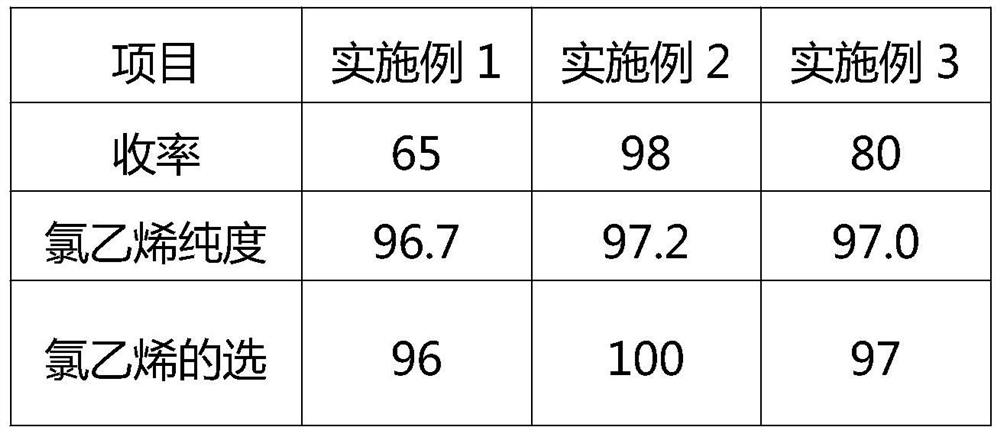Method for preparing ultralow-mercury catalyst by recycling waste batteries
A waste battery, ultra-low mercury technology, applied in battery recycling, recycling technology, recycling by waste collectors, etc., can solve problems such as high cost, insufficient utilization, and single metal recycling
- Summary
- Abstract
- Description
- Claims
- Application Information
AI Technical Summary
Problems solved by technology
Method used
Image
Examples
Embodiment 1
[0036] A method for recycling waste batteries to prepare ultra-low mercury catalysts, extracting and separating valuable elements from battery powder obtained by dismantling waste batteries, and preparing vinyl chloride to synthesize ultra-low mercury catalysts, comprising the following steps:
[0037] S1, stirring and extracting the battery powder obtained by dismantling the waste battery and dilute hydrochloric acid, and taking the extract;
[0038] S2. After the extract is filtered and separated, analyze the content of mercury, zinc, manganese, copper, cadmium, nickel and cobalt in the extract, and add a regulator by weight to adjust the mercury, zinc, manganese, The ratio of copper, cadmium, nickel and cobalt is 4:2:2:1:1:0.1:0.1, the solution has to be adjusted;
[0039] S3. The adjusted solution is soaked in activated carbon and dried to obtain a catalyst.
[0040] The step s1 is adding battery powder and dilute hydrochloric acid into a stirring tank, adding hydrogen pe...
Embodiment 2
[0043] A method for recycling waste batteries to prepare ultra-low mercury catalysts, extracting and separating valuable elements from battery powder obtained by dismantling waste batteries, and preparing vinyl chloride to synthesize ultra-low mercury catalysts, comprising the following steps:
[0044] S1, stirring and extracting the battery powder obtained by dismantling the waste battery and dilute hydrochloric acid, and taking the extract;
[0045] S2. After the extract is filtered and separated, analyze the content of mercury, zinc, manganese, copper, cadmium, nickel and cobalt in the extract, and add a regulator by weight to adjust the mercury, zinc, manganese, The ratio of copper, cadmium, nickel and cobalt is 4:5:5:3:3:1:1, the solution has to be adjusted;
[0046] S3. The adjusted solution is soaked in activated carbon and dried to obtain a catalyst.
[0047] The aforementioned method of recycling waste batteries to prepare an ultra-low mercury catalyst, the step s1 is ...
Embodiment 3
[0050] A method for recycling waste batteries to prepare ultra-low mercury catalysts, extracting and separating valuable elements from battery powder obtained by dismantling waste batteries, and preparing vinyl chloride to synthesize ultra-low mercury catalysts, comprising the following steps:
[0051] S1, stirring and extracting the battery powder obtained by dismantling the waste battery and dilute hydrochloric acid, and taking the extract;
[0052] S2. After the extract is filtered and separated, analyze the content of mercury, zinc, manganese, copper, cadmium, nickel and cobalt in the extract, and add a regulator by weight to adjust the mercury, zinc, manganese, The ratio of copper, cadmium, nickel and cobalt is 3:6:6:5:5:1:1, the solution has to be adjusted;
[0053] S3. The adjusted solution is soaked in activated carbon and dried to obtain a catalyst.
[0054] The step s1 is adding battery powder and dilute hydrochloric acid into the stirring tank, adding hydrogen pero...
PUM
 Login to View More
Login to View More Abstract
Description
Claims
Application Information
 Login to View More
Login to View More - R&D
- Intellectual Property
- Life Sciences
- Materials
- Tech Scout
- Unparalleled Data Quality
- Higher Quality Content
- 60% Fewer Hallucinations
Browse by: Latest US Patents, China's latest patents, Technical Efficacy Thesaurus, Application Domain, Technology Topic, Popular Technical Reports.
© 2025 PatSnap. All rights reserved.Legal|Privacy policy|Modern Slavery Act Transparency Statement|Sitemap|About US| Contact US: help@patsnap.com


